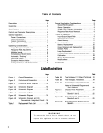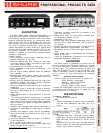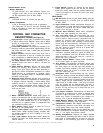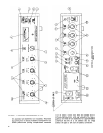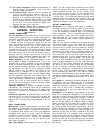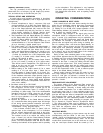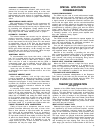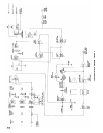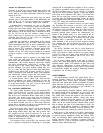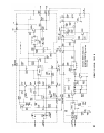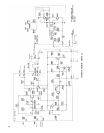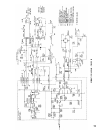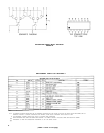OPERATING CONSIDERATIONS (Cont’d)
conference or conversation situation, with several micro-
phones “live” but only one speaker talking at a time, each
Input control should be set so that each speaker results in
approximately the same amount of compression, observing
that the overall level is correct for proper Gated Memory
action.
SIMULTANEOUS MIXED INPUTS
With simultaneous (mixed) inputs, the compressor will
automatically maintain a constant overall output level, so
that the balance among the sources may be adjusted easily
by monitoring with headphones. Simply observe that the
DB Compression meter (7) is reading in the normal oper-
ating range and that Gated Memory action is proper.
AUTOMATIC “DUCKING”
The balance between two sources may be adjusted to
produce automatic “ducking,” for example, for an an-
nouncer’s voice over musical programming. In this case,
set the Input control for the music source for a low amount
of compression, such as 5 dB. Then set the announcer’s
microphone Input control for 15 dB compression when he
is speaking. When the announcer talks during music, the
SE30’s gain will be reduced by 10 dB, “ducking” the music
level below the voice level by that amount. When he stops
speaking, the music will return to full output.
ADDITIONAL INPUTS
To accommodate more inputs than three, a Mix Bus
jack (12) is provided which may be connected to a similar
jack on another SE30 or M67 Mixer. When a Mixer
with a mix bus is used in conjunction with the SE30, a
compressed output may be obtained from the SE30, and
an uncompressed output of the same mixed material will
be available from the Mixer.
Inputs may also be added by connecting the line level
or microphone level output of another mixer to one of the
SE30 inputs.
EXCESSIVE AMBIENT NOISE
Under certain conditions, such as high noise levels,
it may be impossible to adjust the Input control (1) so that
the Gated Memory can consistently discriminate between
background and program. In such a case, the Gated Mem-
ory switch (21) should be set to Disable and the amount of
compression should be reduced to minimize the audible
effects of “pumping.”
In extremely severe cases, compression should not be
used at all, since the increase in background noise during
pauses will be quite unpleasant. The SE30 may then be
used as a high-quality linear mixer by setting the Comp.
switch (22) to DISABLE and setting the Meter switch (8)
to VU to monitor output level. As with any mixer it will then
be desirable to set the Input control (1) as high as pos-
sible without clipping, and set the output VU level with
the Output control (7), to provide best signal-to-noise ratio.
FADING TECHNIQUE WITH COMPRESSION
Fading of inputs with a compressor must be accom-
plished somewhat differently than with a linear mixer.
Since a slow reduction of input level within the compres-
sion region will be compensated for by an increase in
gain, no audible fading will occur. Consequently, fading
an input down should be done rapidly, at least to the point
at which the Gated Memory changes to the “hold” state.
For overall program fades, it is desirable to use the
Output control (3), since it does not affect the amount of
compression but only the output level.
SPECIAL APPLICATION
CONSIDERATIONS
SOUND REINFORCEMENT
The SE30 may be used in sound reinforcement installa-
tions, but some care must be exercised in such applica-
tions. Since this compressor can only reduce its gain when
a signal exceeds its compression threshold, maximum gain
occurs with low signal levels, and the sound-reinforcement
system’s gain must be adjusted to be stable (no ringing or
howling) with no compressor gain reduction. This may be
accomplished by adjusting system gain with the SE30’s
Comp. switch (22) set to DISABLE. With proper system
adjustment, the SE30 may be used to level the sound of
a “wavering” speaker, or to prevent power amplifier over-
drive with extremely strong signals.
STEREO OPERATION
Two SE30’s may be synchronized to operate together for
stereo applications by interconnecting their Stereo Parallel
jacks (23) and performing the adjustment procedure out-
lined in the Service Section of the manual.
One unit will compress the left channel signal and the
other will compress the right channel signal, but both will
respond equally to the sum (left and right) signal to mini-
mize apparent stereo image shift.
Because of the necessity of providing the two units
with a properly balanced stereo signal, it is recommended
that stereo applications be restricted to single inputs for
each channel, with mixing and balancing being accom-
plished in another mixer prior to the SE30’s.
SINGLE INPUT PROGRAM COMPRESSOR
When the SE30 is used as a single line input, perma-
nently installed program compressor, it is possible to im-
prove the signal-to-noise ratio by disabling two of the
inputs and thus reducing the electrical noise of the mixing
system. This modification is outlined in the Service Section.
RESPONSE RATE KNOB REMOVAL
To prevent inadvertent misadjustment of the Response
Rate control (6) the knob may be removed and the hole
filled with the plastic plug included with the SE30. This
procedure is described in the Service Section.
THEORY OF OPERATION
(See Figure 3)
Operation of the SE30 Gated Compressor/Mixer may be
explained by referring to the Functional Block Diagram,
Figure 3. The active devices in each stage, as well as other
important components, are identified by their reference
numbers, for ease of location on the Schematic Diagram
(Figure 4) and the Chassis Parts and Printed Circuit Board
Parts Placement diagrams (Figures 5 and 6). The first digit
of three-digit references indicates the printed circuit board
upon which the part is located.
INPUT-OUTPUT SIGNAL PATH
Balanced input signals entering through J1, J2, and J3
are amplified by the three transformer-coupled, variable-
gain input preamplifiers. Low-level signals are applied di-
rectly to the transformer primaries, and high-level (line)
signals are attenuated by balanced -48 dB resistive pads.
The Input controls are ganged, dual-section potentiometers
arranged such that a reduced control setting increases the
negative feedback around the stage, thus reducing gain
and increasing the input clipping level. Since the pream-
plifier stage gain cannot be reduced below 6 dB from its
9




